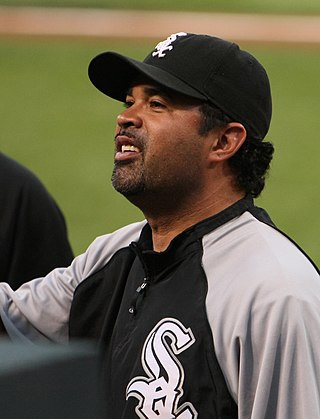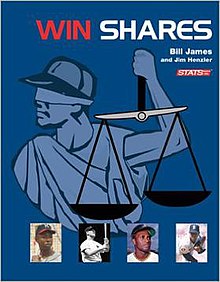Baseball statistics refers to a variety of metrics used to evaluate player and team performance in the game of baseball.

In sports analytics, sabermetrics is the empirical analysis of baseball, especially baseball statistics that measure in-game activity. Sabermetricians collect and summarize the relevant data from this in-game activity to answer specific questions. The term is derived from the acronym SABR, which stands for the Society for American Baseball Research, founded in 1971. The term "sabermetrics" was coined by Bill James, who is one of its pioneers and is often considered its most prominent advocate and public face.

George William James is an American baseball writer, historian, and statistician whose work has been widely influential. Since 1977, James has written more than two dozen books about baseball history and statistics. His approach, which he named sabermetrics after the Society for American Baseball Research (SABR), scientifically analyzes and studies baseball, often through the use of statistical data, in an attempt to determine why teams win and lose.

The Rawlings Gold Glove Award, usually referred to as simply the Gold Glove or Golden Glove, is the award given annually to the Major League Baseball (MLB) players judged to have exhibited superior individual fielding performances at each fielding position in both the National League (NL) and the American League (AL). The Gold Glove is widely considered one of the most prestigious defensive awards in baseball.

Moneyball: The Art of Winning an Unfair Game is a book by Michael Lewis, published in 2003, about the Oakland Athletics baseball team and its general manager Billy Beane. It describes the team's sabermetric approach to assembling a competitive baseball team on a small budget. It led to the 2011 film Moneyball, starring Brad Pitt and Jonah Hill.

Oswaldo José Guillén Barrios is a Venezuelan-American former professional baseball player who is the current manager of Tiburones de La Guaira of the Venezuelan League. He played in Major League Baseball as a shortstop for 16 seasons, primarily with the Chicago White Sox, from 1985 to 2000. During that time, he won the American League Rookie of the Year Award and also a Gold Glove. He was considered one of the best defensive shortstops of his era. Guillen later managed the Chicago White Sox from 2004 to 2011, winning the World Series in 2005 and then moving to the Miami Marlins in 2012.
Secondary average, or SecA, is a baseball statistic that measures the sum of extra bases gained on hits, walks, and stolen bases depicted per at bat. Created by Bill James, it is a sabermetric measurement of hitting performance that seeks to evaluate the number of bases a player gained independent of batting average. Unlike batting average, which is a simple ratio of base hits to at bats, secondary average accounts for power, plate discipline (walks), and speed. Secondary averages have a higher variance than batting averages.

Theodore Amar Lyons was an American professional baseball starting pitcher, manager and coach in Major League Baseball (MLB). He played in 21 MLB seasons, all with the Chicago White Sox. He is the franchise leader in wins. Lyons won 20 or more games three times and became a fan favorite in Chicago.

Baseball Prospectus (BP) is an organization that publishes a website, BaseballProspectus.com, devoted to the sabermetric analysis of baseball. BP has a staff of regular columnists and provides advanced statistics as well as player and team performance projections on the site. Since 1996 the BP staff has also published a Baseball Prospectus annual as well as several other books devoted to baseball analysis and history.

Paul DePodesta is an American football executive and former baseball executive who is the chief strategy officer of the Cleveland Browns of the National Football League (NFL). He previously served as a front-office assistant for the Cleveland Indians, Oakland Athletics, and New York Mets of Major League Baseball (MLB). DePodesta was also general manager of MLB's Los Angeles Dodgers. He is also known for his appearance in the book and movie Moneyball about his early career as an assistant with the Athletics.
Robert "Voros" McCracken is an American baseball sabermetrician. "Voros" is a nickname from his partial Hungarian heritage. He is widely recognized for his pioneering work on Defense Independent Pitching Statistics (DIPS).

James Anthony Shields is an American former professional baseball starting pitcher. He played in Major League Baseball (MLB) for the Tampa Bay Rays from 2006 through 2012, the Kansas City Royals in 2013 and 2014, the San Diego Padres in 2015 and 2016, and the Chicago White Sox from 2016 to 2018. He was an All Star in 2011.
Craig R. Wright pioneered the use of sabermetrics in major league baseball, and is a baseball writer and historian.
Baseball Think Factory, abbreviated as BTF or BBTF, was a sabermetrically-oriented baseball web site which featured daily news stories in baseball, with original content contributed by SABR members such as Dan Szymborski. The site was previously branded as Baseball Primer, and was created in 2001 by the founders of Baseball-Reference. Contributors who have gone on to work for Major League Baseball front offices include Voros McCracken, Carlos Gomez, and Tom Tango. Bill James' Baseball Abstract books published in the 1980s are widely considered to be the modern predecessor to websites using sabermetrics such as baseballthinkfactory and baseballprospectus.
In baseball, wOBA is a statistic, based on linear weights, designed to measure a player's overall offensive contributions per plate appearance. It is formed from taking the observed run values of various offensive events, dividing by a player's plate appearances, and scaling the result to be on the same scale as on-base percentage. Unlike statistics like OPS, wOBA attempts to assign the proper value for each type of hitting event. It was created by Tom Tango and his coauthors for The Book: Playing the Percentages in Baseball.
Baseball Almanac is an interactive baseball encyclopedia with over 500,000 pages of baseball facts, research, awards, records, feats, lists, notable quotations, baseball movie ratings, and statistics. Its goal is to preserve the history of baseball.
Wins Above Replacement or Wins Above Replacement Player, commonly abbreviated to WAR or WARP, is a non-standardized sabermetric baseball statistic developed to sum up "a player's total contributions to his team". A player's WAR value is claimed to be the number of additional wins his team has achieved above the number of expected team wins if that player were substituted with a replacement-level player: a player who may be added to the team for minimal cost and effort.

A Fielding Bible Award recognizes the best defensive player for each fielding position in Major League Baseball (MLB) based on statistical analysis. John Dewan and Baseball Info Solutions conduct the annual selection process, which commenced in 2006. The awards are voted on by 10 sabermetrically inclined journalists and bloggers including Dewan, sabermetric pioneer Bill James, and writers such as Peter Gammons, NBC Sports' Joe Posnanski, SB Nation editor Rob Neyer, and ESPN analyst Doug Glanville. The awards have historically been announced before the Gold Glove Awards, the traditional measurement of fielding excellence. Dewan wrote that this award cannot equal the prestige of the Gold Glove, which started 50 years earlier, but it provides an alternative.

The Wilson Defensive Player of the Year Award was awarded annually to the best defensive player at each fielding position in Major League Baseball (MLB). The award was given between 2012 and 2019. An overall Defensive Player of the Year and a Defensive Team of the Year were also selected annually. Unlike the Rawlings Gold Glove Awards, which are voted on by major league managers and coaches, the Wilson Defensive Player of the Year Award winners were determined by statistics using sabermetrics.
Sports analytics are collections of relevant historical statistics that can provide a competitive advantage to a team or individual. Through the collection and analysis of these data, sports analytics inform players, coaches and other staff in order to facilitate decision making both during and prior to sporting events. The term "sports analytics" was popularized in mainstream sports culture following the release of the 2011 film, Moneyball, in which Oakland Athletics General Manager Billy Beane relies heavily on the use of baseball analytics, building upon and extending the established practice of Sabermetrics, to build a competitive team on a minimal budget.










